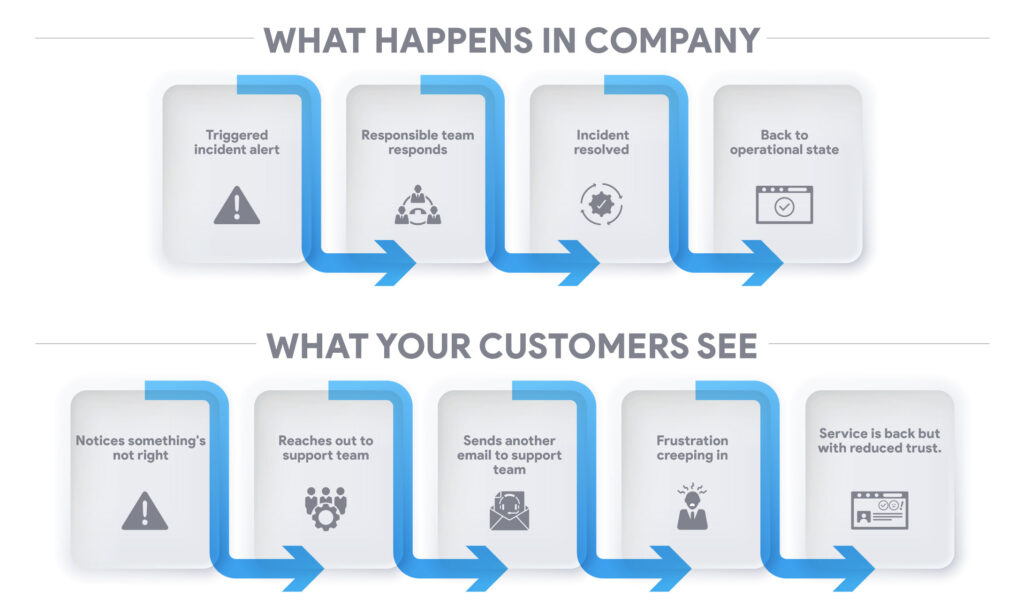Top 6 Best Practices for Incident Communication
Nov 07, 2023 | 42Gears Team
Let's face it, incidents are normal. There's no way to have a product or software that's completely free from glitches or downtime. It happens, and it's perfectly normal.
However, when major incidents happen, they interfere with business operations and sometimes even affect security and integrity of company and customer. But while the effects of these incidents are immediately visible during normal operations, the big and lasting impacts are your company’s reputation with your shareholders, employees, and customers.

The primary aim of a company's incident communication plan should be to lead the narrative while also demonstrating transparency. In this blog, we'll dive into the best practices for incident communication and also explore how AstroStatus, an incident communication solution, can elevate your incident management efforts.
Top 6 Best Practices for Incident Communication
- Prepare in Advance
- Create an Incident Response Plan: Develop a comprehensive plan that outlines roles, responsibilities, and communication strategies for different scenarios. This plan should include a well-defined chain of command so everyone knows their roles during an incident.
- Designate a Spokesperson/Team: Clearly identify who will be responsible for communicating with the affected parties and the media. It would become chaotic if multiple teams communicate with end users. The designated team/person should have a thorough understanding of the incident and communicate the same clearly.
- Be Transparent
- Transparency Wins: Always be honest and transparent about the incident, its causes, and the steps being taken to address it. Your customers will greatly appreciate this approach. Avoid downplaying the issue or hiding information.
- Acknowledge the Impact: Recognize the impact of the incident on those affected, and express empathy and concern. Show that you understand the inconvenience or harm caused, and that you're committed to resolving it.
- Timely and Consistent Updates
- Regular Updates: Provide regular updates on the incident's status, progress, and expected resolution time. Confirm that the incident is still being actively addressed. This will instill confidence in your customers that you have control over the situation.
- Consistency: Ensure that all communication channels convey the same message to avoid confusion. Consistency across all communication platforms builds credibility.
- Utilize Multiple Communication Channels
- Diversify Channels: Use a mix of communication channels, including social media, email, your website to reach as many stakeholders as possible. Different people prefer different channels, so this ensures your message is widely disseminated.
- Two-way Communication: Encourage questions from your audience and provide a means for them to reach out to you. Respond promptly to inquiries to maintain an open line of communication.
- Tailor Messages to the Audience
- Segmentation: Different stakeholders may require different information. Tailor your messages to meet the needs of each audience. For example, customers may be more interested in how the incident affects them, while shareholders may be concerned about the financial impact.
- Accurate Targeting: Make sure the information you're sending is specifically targeted to customers who are directly affected.There's no point in sending a general message to all customers, especially when some may not be using the service that's experiencing downtime.
- Learn and Improve
- Post-Incident Analysis: After the incident is resolved, conduct a post-incident analysis to identify what went well and what could be improved in your communication strategy. This analysis should include feedback from both internal and external sources.
- Continuous Improvement: Use this analysis to refine your incident response plan and communication practices. Learn from each incident to better prepare for future ones.
AstroStatus Can Enhance Your Incident Communication
AstroStatus is a powerful solution designed to optimize and elevate incident communication, and also help you adhere to the best practices outlined in this blog. It centralizes incident reporting for IT teams and provides real-time updates to stakeholders. With features like audience-specific status pages, templates, service monitoring, and more, you can easily ensure transparent and efficient incident management, ultimately safeguarding trust and preserving your organization's reputation.
Implement Incident CommunicationBest Practices with AstroStatus
Subscribe for our free newsletter


